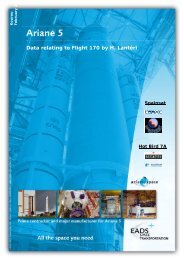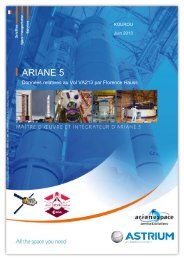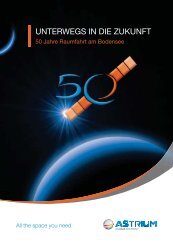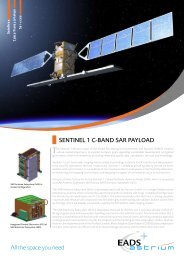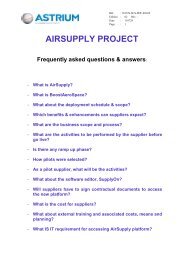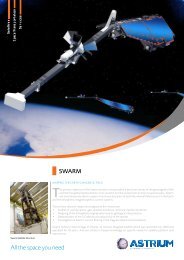LION NavIgatOr - Astrium
LION NavIgatOr - Astrium
LION NavIgatOr - Astrium
Create successful ePaper yourself
Turn your PDF publications into a flip-book with our unique Google optimized e-Paper software.
<strong>LION</strong> Navigator<br />
multi-constellation and multi-frequency GNSS<br />
receiver for space applications<br />
Based on <strong>Astrium</strong> Products’ heritage in the development of HiRel space<br />
GNSS receivers, the new generation navigation receiver “<strong>LION</strong> Navigator”<br />
delivers high performance supporting both multiple frequency reception<br />
and multiple navigation constellation operation. Advances in navigation<br />
signal processing technology enable the development of a next generation<br />
of navigation receivers. GPS is being modernised, providing more civil<br />
signals, and first Galileo test satellites are already in orbit. Therefore, the<br />
new <strong>Astrium</strong> Products’ <strong>LION</strong> Navigator is designed to make use of the GPS<br />
signals L1, L2C, and L5 and of the Galileo signals E1, E5a and E5b, as well as<br />
Glonass and Compass open signals*. 36 channels in parallel are available to<br />
track all satellites in view.<br />
The <strong>LION</strong> Navigator is designed to demodulate the navigation data messages<br />
of the GNSS constellations navigation signals and to use this information for<br />
PVT determination through an instant point-solution as well as through a<br />
dynamic Kalman-filtered solution.<br />
The <strong>LION</strong> Navigator reaches a very high level of integration and performance<br />
thanks to the use of an ASIC as the core of the receiver. This ASIC (AGGA-4),<br />
developed by <strong>Astrium</strong> Products’ under ESA contract, gathers in a single chip a<br />
modern GNSS baseband processor, a LEON-FT as a fault-tolerant microprocessor<br />
with FPU, a FFT module and digital interfaces (1553, UART, SpW).<br />
* on request for Glonass and Compass<br />
Key features<br />
• Multi-Constellation Receiver:<br />
- Galileo<br />
- modernised GPS<br />
- GLONASS, Compass using interoperability of Galileo<br />
and GPS<br />
• Multi-Frequency Receiver:<br />
- L1/E1 Band<br />
- L2C Band<br />
- L5/E5 Band<br />
• Multi-Use:<br />
- Platform<br />
- Payload (Scientific Receiver)<br />
• High precision real time performance using 36<br />
channels<br />
• Centimetre post-processing capability on ground<br />
• Available in different configurations from single to<br />
quadruple frequency<br />
• Compatibility mode to the interfaces used by <strong>Astrium</strong><br />
Products’ MosaicGNSS receiver<br />
Main application field<br />
• LEO, MEO and GEO satellites<br />
Interfaces<br />
• Communication<br />
• Up to 4 antennas capability<br />
• Power supply 18-60 V<br />
MIL-STD-1553 Bus,<br />
SpaceWire, UART<br />
Performances<br />
• Accuracy < 2 metres 3D RMS LEO<br />
(triple freq.) < 2.5 mm/sec 3D RMS LEO<br />
Time<br />
50ns pps<br />
Budget<br />
• Mass<br />
5 kg (without antenna,<br />
RF harness and LNA)<br />
200mm x 140mm x 205mm<br />
< 20 W<br />
• Volume<br />
• Power Consumption<br />
• Complete cold redundancy in one box<br />
Environment<br />
• Temperature<br />
• Radiation<br />
• Life time<br />
-20 ˚C to +50 ˚C (operating)<br />
-30 ˚C to +60 ˚C (non-operating)<br />
50 krad total dose<br />
15 years<br />
All the space you need
<strong>LION</strong> Navigator assembly<br />
The typical complete redundant <strong>LION</strong> Navigator assembly<br />
is composed of:<br />
• Two <strong>LION</strong> Navigator Receiver Units<br />
• Two LNA Units<br />
• Two GNSS Antennas<br />
• Associated RF cables between above components<br />
Up to four GNSS Antennas can be connected to each nonredundant<br />
<strong>LION</strong> Navigator Receiver Unit, e.g. for scientific<br />
applications.<br />
The communication options for the fully redundant<br />
connection with the onboard computers are:<br />
• MIL-STD-1553 Bus<br />
• Cross-strapped SpaceWire<br />
• Cross-strapped UART<br />
<strong>LION</strong> Navigator architecture<br />
GNSS<br />
Antenna<br />
L<br />
N<br />
A<br />
RF Frame<br />
Clock<br />
Module<br />
RF<br />
Front-End<br />
L1 L2 L5<br />
Power<br />
Converter<br />
Digital Board<br />
:<br />
<strong>LION</strong> Navigator Assembly with MIL-STD-1553 Bus<br />
Antenna A<br />
LNA A<br />
Antenna B<br />
RAM PROM EEPROM<br />
GNSS<br />
Core<br />
PPS<br />
Space<br />
Wire<br />
AGGA-4<br />
UART<br />
LNA B<br />
<strong>LION</strong> Navigator<br />
Redundant Box<br />
Receiver<br />
Unit A<br />
Receiver<br />
Unit B<br />
<strong>LION</strong> Navigator Assembly with cross-strapped SpaceWire or UART<br />
LEON<br />
CPU<br />
MIL<br />
STD<br />
1553<br />
SpaceWire or UART<br />
Cross-Strapping<br />
Onboard<br />
Computer<br />
A<br />
Onboard<br />
Computer<br />
B<br />
PDH-9 / Non-contractual document, subject to changes. This document shall not be reproduced, in whole or in part, without prior consent. © 2012 <strong>Astrium</strong> [Ltd/SAS/GmbH]<br />
<strong>LION</strong> Navigator<br />
<strong>LION</strong> Navigator Receiver Unit<br />
The <strong>LION</strong> Navigator is based on the AGGA-4,<br />
which comprises a complete GNSS core with<br />
36 baseband channels, the LEON-FT as a<br />
fault-tolerant micro-processor together with a<br />
FPU, a FFT module and digital communication<br />
interfaces (MIL-STD-1553, UART, SpaceWire). On<br />
its digital board it is complemented with RAM,<br />
Boot Loader PROM, and an EEPROM to store the<br />
GNSS Application.<br />
The modular design of the RF frame provides<br />
for each GNSS frequency a narrow-band RF<br />
front-end.<br />
A central OCXO provides the highly precise<br />
reference clock to all modules.<br />
Optional add-on services<br />
• Mission analysis, specific compatibility tests<br />
• EGSE for closed loop testing<br />
• AOCS integration and hardware<br />
accommodation support<br />
• Pre-& post-launch maintenance<br />
• Operator training<br />
Contact:<br />
astrium products<br />
products@astrium.eads.net<br />
www.astrium.eads.net



